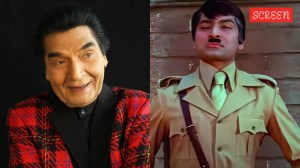Love & Longing
Kolkata-based group Nandikars play Ajnatobaas explores the concept of loneliness in the modern society.
Kolkata-based group Nandikars play Ajnatobaas explores the concept of loneliness in the modern society.
Ajnatobaas starts off with an elderly lady,Mrs Banerjee,stepping into the home of a newly-married,happy young woman Payel. She crosses the fenced gate to ask the younger woman for a glass of water. Payel finds a temporary friend to spend her lonely hours with as her husband is a busy man. The thirst for water is just the beginning of a tragic story that many people in the audience identify with. Who is this lady? Where does she come from? Why is Payels husband Soumik sceptical about her? The old woman does not have any memory of her identity,her origin and her residence.
She suffers from phases of amnesia but she is not an Alzheimers patient. She surprises the family physician with her knowledge about memory ailments that senior citizens are prone to. The police inspector,failing to trace her address discovers motherly love in her. After the initial scepticism,Payels husband is bowled over by her culinary prowess. Payel loves to hear her sing and joins her at times. I remember everything, she suddenly bursts out the following morning and gets ready to leave. Payels husband drops her off at a place as she insists that he should go back earlier and not leave her at her doorstep. But the play raises fundamental questions like does this woman really have a home? Do Payel and her husband have a real home? Or are we biding our time at some remote railway station?
Ajnatobaas,a single-set play revolves around the mystery of the womans identity. Characters move in and out of the play and gradually multiple layers of their personalities are revealed. They are not only suspicious about the woman but are also intrigued by her. The story is narrated in flashback by Payel,now an ageing widow who lives alone in a spacious home. I depend on the lock on my gate more than on any person for my safety, she tells her daily maid as she twists the key in the lock firmly. The lock on the grilled gate is the only remnant of a family that once was.
Ajnatobaas uses monochrome film clips on a large screen to reveal the twist in the tale in the sad climax. One gets to see enlarged still photographs in black-and-white of sad,old and lonely faces in close-up. The music sets the mood for the play. It both complements as well as enriches the narrative. Refrains of the Tagore song Hridayer ekul okul dukul bheshey jai blends into the philosophy of the play.
The large screen uses strategic lighting with long shadows on the wall to show how Payels home,like most homes today,resembles a large cage in which a bird is held captive. The captivity is literal and metaphorical – you do not like to stay in,but you have no way of getting out even if you want to. The lighting shifts focus from character to character,from a joyful mood to a pensive one,sometimes playing on their faces. Swatilekha Sengupta,who has also directed the play,based on Sukanta Gangopadhyays story,gives her career-best performance as Mrs Banerjee,whose true identity is not revealed till the end. Sohini Sengupta as Payel could have been a little bit less sweet and syrupy. Sumanto Ganguly as her husband,Soumik,is very good too except in the last scene where he breaks down and begins to cry.
Ajnatobaas raises questions like do all of us have to lead a lonely life spent in forced exile and what the future holds for us? At the end of the play,the now-aged Payal picks up her bag,opens the door and steps out of the fenced gate. You must be wondering where I am going. Could be to your house,or yours,or yours? she asks the audience,spelling out the tragedy of getting old and unloved in a world sans roots and belonging.





- 01
- 02
- 03
- 04
- 05


























